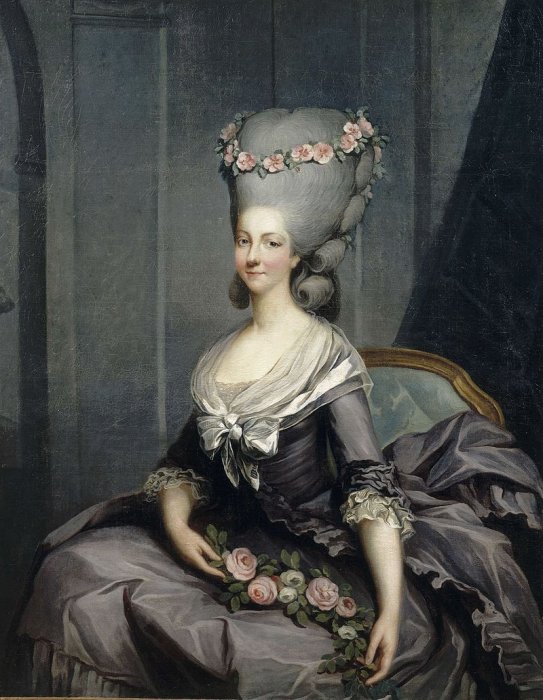Daily Life Of A Lady In Waiting – A Dangerous Profession Sometimes
Ellen Lloyd - AncientPages.com - Would you like to have a personal assistant who helps you with your daily routines? Most of us have to cope with everyday duties on our own. Not many can afford such luxury; frankly, some would even feel embarrassed if a stranger was always there and assisted us.
The duties of ladies in waiting varied from court to court. Credit: Franz Xaver Winterhalter - Public Domain
It was, however, a completely different story in England during the Tudor and Elizabethan Eras (1485 – 1602). In those days, a lady in waiting was a profession that could sometimes even be slightly dangerous. A lady-in-waiting could be found in most European royal courts, not only the English one.
Power Of Royal Women
Royal women "exercised significant influence and power in most early modern societies, whether as rulers in their own right in the wives or mothers of kings. They possessed their residential quarters and households that provided them with a store of patronage; these physical environments, primarily dominated by women, often developed into important social and political centers.
There is, accordingly, every reason to think that a 'politics of intimacy' should have developed around queens and kings, in which female courtiers would have been actively involved. Even if they could not typically hold judicial and administrative offices in the administration of royal government or lead armies and embassies, some women were
Well-placed to gather and spread inside information, influence the distribution of certain forms of patronage, and facilitate contacts and agreement between powerful men and women." 1
Daily Life And Duties Of A Lady In Waiting
Being a lady in waiting (also called a waiting maid) may sound like a simple job. Still, it was a respectable profession, and this woman had access to vital royal information.
Only a noblewoman could become a lady in waiting. The woman was chosen from a high society by the queen herself.
Several examples of renowned ladies in waiting later became prominent historical figures. One famous lady in waiting was Jane Seymour (1508 –1537), who eventually became a queen. She was the third wife of King Henry VIII.
Marie Louise of Savoy-Carignan, Princesse de Lamballe was lady-in-waiting to Queen Marie Antoinette of France. Credit: Public Domain
Sadly, Jane Seymour died during childbirth, but at least she had more luck than several of Henry VIII's other wives who the king executed. Seymour was the only one of Henry's wives to receive a queen's funeral and his only consort to be buried beside him in St George's Chapel, Windsor Castle.
A lady in waiting can be best described as a personal assistant whose job is to accompany a queen, a princess, or a noblewoman, as a trusted companion. She helped dress and ensured that the lady she served was always entertained. Popular entertainment in those days included riding, painting, and embroidery.
As belonging to the royal court, a lady-in-waiting was also expected to participate in balls and masques. On those occasions, she could establish contact with prominent people. Having powerful links, a lady-in-waiting had many possibilities to make an impression on the English nobility.
Another essential duty of a lady-in-waiting was to keep the queen updated with the latest gossip from the royal court. A lady in waiting always knew what was happening, and she frequently heard conversations of monarchs, which was also why she could quickly be drawn into a scandal.
She also had to deal with all kinds of correspondence. She read letters to the queen and wrote on her behalf. There wasn't much a lady in waiting didn't know about as the queen's most trusted friend.
This kind of intimacy could benefit her future career, but sometimes also troublesome in case of existing problems at the court. It also explains why a lady-in-waiting could quickly be drawn into a scandal.
Written by Ellen Lloyd – AncientPages.com
Updated on December 21, 2023
Copyright © AncientPages.com All rights reserved. This material may not be published, broadcast, rewritten or redistributed in whole or part without the express written permission of AncientPages.com
Expand for references1. Smuts, R. Malcolm, Nadine Akkerman, and Birgit Houben. Early Modern Women 9, no. 2 (2015): 189-92.
Harris, Barbara J. "Women and Politics in Early Tudor England." The Historical Journal 33, no. 2 (1990): 259-81.
More From Ancient Pages
-
 Is This The Face of Queen Elizabeth I?
Archaeology | Oct 15, 2018
Is This The Face of Queen Elizabeth I?
Archaeology | Oct 15, 2018 -
 Scientists Reveal What Egyptian Faience Have To Do With Gold
Archaeology | Dec 17, 2022
Scientists Reveal What Egyptian Faience Have To Do With Gold
Archaeology | Dec 17, 2022 -
 Long Mysterious Tunnel Discovered Inside The Khufu Pyramid
Archaeology | Mar 2, 2023
Long Mysterious Tunnel Discovered Inside The Khufu Pyramid
Archaeology | Mar 2, 2023 -
 Red Paint On 1,000-Year-Old Gold Mask From Peru Contains Human Blood Proteins
Archaeology | Nov 1, 2021
Red Paint On 1,000-Year-Old Gold Mask From Peru Contains Human Blood Proteins
Archaeology | Nov 1, 2021 -
 Artemisia I Of Caria – Pirate Queen And Ally Of Xerxes I Was Loyal To No-One Except Herself
Featured Stories | Mar 4, 2019
Artemisia I Of Caria – Pirate Queen And Ally Of Xerxes I Was Loyal To No-One Except Herself
Featured Stories | Mar 4, 2019 -
 2,000-Year-Old Huge Terracotta Jar Discovered In Turkey
Archaeology | Jan 2, 2018
2,000-Year-Old Huge Terracotta Jar Discovered In Turkey
Archaeology | Jan 2, 2018 -
 Nobel Prize: Svante Pääbo’s Ancient DNA Discoveries Offer Clues As To What Makes Us Human
DNA | Oct 12, 2022
Nobel Prize: Svante Pääbo’s Ancient DNA Discoveries Offer Clues As To What Makes Us Human
DNA | Oct 12, 2022 -
 Mystery Of The Bar Hill Comb Solved
Archaeology | Mar 13, 2023
Mystery Of The Bar Hill Comb Solved
Archaeology | Mar 13, 2023 -
 Wayland The Smith: Legendary Master Blacksmith And Lord Of The Elves
Featured Stories | Jul 14, 2016
Wayland The Smith: Legendary Master Blacksmith And Lord Of The Elves
Featured Stories | Jul 14, 2016 -
 Young Boy Discovers Rare Ancient Roman Treasure In Sussex, UK
Archaeology | Apr 15, 2024
Young Boy Discovers Rare Ancient Roman Treasure In Sussex, UK
Archaeology | Apr 15, 2024 -
 Yamna Culture Started Cannabis Trade 5,000 Years Ago
Ancient History Facts | Aug 6, 2016
Yamna Culture Started Cannabis Trade 5,000 Years Ago
Ancient History Facts | Aug 6, 2016 -
 Is There A Hidden Ancient Message Inside San Miniato Al Monte Basilica?
Featured Stories | Oct 3, 2022
Is There A Hidden Ancient Message Inside San Miniato Al Monte Basilica?
Featured Stories | Oct 3, 2022 -
 142,000-Year-Old Shell Beads Found In A Cave Are The Oldest Known Evidence Of Human Communication
Archaeology | Oct 16, 2021
142,000-Year-Old Shell Beads Found In A Cave Are The Oldest Known Evidence Of Human Communication
Archaeology | Oct 16, 2021 -
 Feud Between The Medici And The Borgia Families – What Caused The Renaissance Clash?
Featured Stories | Mar 5, 2019
Feud Between The Medici And The Borgia Families – What Caused The Renaissance Clash?
Featured Stories | Mar 5, 2019 -
 The Great Pyramid And Ancient Egyptian Knowledge Shed Light On Biblical Mysteries – Surprising Information – Part 2
Biblical Mysteries | Nov 27, 2019
The Great Pyramid And Ancient Egyptian Knowledge Shed Light On Biblical Mysteries – Surprising Information – Part 2
Biblical Mysteries | Nov 27, 2019 -
 Egyptian King Seti I Documented His 3300-Year-Old Accomplishment On Triumphal Stele
Archaeology | Feb 27, 2023
Egyptian King Seti I Documented His 3300-Year-Old Accomplishment On Triumphal Stele
Archaeology | Feb 27, 2023 -
 Ancient Secrets Of Sophisticated Jama-Coaque People
Civilizations | Sep 27, 2016
Ancient Secrets Of Sophisticated Jama-Coaque People
Civilizations | Sep 27, 2016 -
 Rare Discovery Of A 2,500-Year-Old Ancient Receipt With The Name Of King Darius The Great
Archaeology | Mar 2, 2023
Rare Discovery Of A 2,500-Year-Old Ancient Receipt With The Name Of King Darius The Great
Archaeology | Mar 2, 2023 -
 Unique 1,300-Year-Old Pala Period Idol Of Snake Goddess, Nag Devi Discovered Near Nalanda University, India
Archaeology | Apr 5, 2022
Unique 1,300-Year-Old Pala Period Idol Of Snake Goddess, Nag Devi Discovered Near Nalanda University, India
Archaeology | Apr 5, 2022 -
 Madagascar Cave Art Hints At Ancient Connections Between Africa And Asia
Featured Stories | Dec 18, 2023
Madagascar Cave Art Hints At Ancient Connections Between Africa And Asia
Featured Stories | Dec 18, 2023


